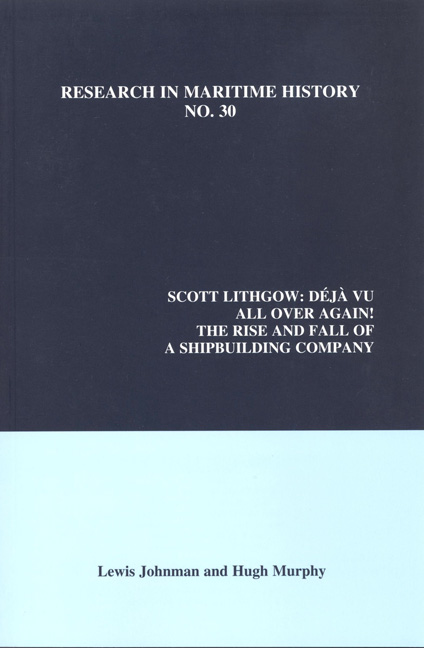Book contents
- Frontmatter
- Contents
- Acknowledgement
- Introduction
- Chapter 1 Scotts of Greenock, 1711-1945
- Chapter 2 Russell and Company to Lithgows Limited, 1874-1945
- Chapter 3 Scotts Shipbuilding and Engineering, 1945-1965
- Chapter 4 Lithgows Limited, 1945-1965
- Chapter 5 The Long March to Merger, 1965-1970
- Chapter 6 The Road to Nationalisation, 1970-1977
- Chapter 7 Nationalisation to Privatisation, 1977-1984
- Chapter 8 Déjà vu All over Again: Trafalgar House, 1984-1988
- Chapter 9 Conclusion
- Appendix
- Bibliography
Introduction
- Frontmatter
- Contents
- Acknowledgement
- Introduction
- Chapter 1 Scotts of Greenock, 1711-1945
- Chapter 2 Russell and Company to Lithgows Limited, 1874-1945
- Chapter 3 Scotts Shipbuilding and Engineering, 1945-1965
- Chapter 4 Lithgows Limited, 1945-1965
- Chapter 5 The Long March to Merger, 1965-1970
- Chapter 6 The Road to Nationalisation, 1970-1977
- Chapter 7 Nationalisation to Privatisation, 1977-1984
- Chapter 8 Déjà vu All over Again: Trafalgar House, 1984-1988
- Chapter 9 Conclusion
- Appendix
- Bibliography
Summary
The antecedents of modern British shipbuilding lie in an atomistic craft industry based on wood and sail, dominated by small-scale family enterprises and partnerships typical of the eighteenth and nineteenth centuries. What shipbuilding there was on the Clyde in the seventeenth and early eighteenth centuries was relatively insignificant in terms of total British output and was based mainly in and around the burgh of Greenock. By 1765 the Greenock firm of John Scott, established in 1711, had began to build its first square-rigged vessel for owners outside Scotland. Thereafter, Scotts and other firms graduated steadily from wood and sail to steam and iron construction as the Clyde became the centre of Scottish shipbuilding. By 1850 the ascendancy of Clyde shipbuilders was apparent and would be further consolidated by local innovations in marine engineering. Further, in common with other major river shipbuilding centres in Britain, iron was the metal of choice on the Clyde for the construction of sailing and steam vessels. The pig-iron industry had expanded rapidly in Scotland, particularly in Lanarkshire and Ayrshire, after the invention in 1828 by James Beaumont Neilson of the hot-blast furnace. This process, and its rapid assimilation, transformed the industry when combined with local deposits of black-band ironstone. Scottish pig-iron production was further improved by the substitution of hard splint coal for coke, which cut coal consumption and increased the amount of pig iron produced.
These improvements gave Scottish shipbuilding a comparative cost advantage over other British producers. But large-scale production of malleable iron lagged behind that of pig. Nevertheless, those malleable iron producers who stuck at it reaped the rewards with the rising demand for high-quality ship plates and marine forgings from Clyde firms. By 1870 Clyde shipbuilders were producing more than two-thirds of all the iron ships built in Britain, and iron producers alone took twenty percent of Scottish coal output. A decade later, local malleable iron manufacturers had sufficient impetus to respond to the growing demand from shipbuilders for the transition from iron to steel plates. This vertically-integrated economy, confined mainly within a distinct area of the West of Scotland, was not the sole explanation for the seemingly inexorable rise of Clyde shipbuilding. Entrepreneurial talent, a ready supply of labour, a plethora of general and marine engineering shops and foundries and good railway and other transport links were also important.
- Type
- Chapter
- Information
- Scott LithgowDéjà Vu all over again! The Rise and Fall of a Shipbuilding Company, pp. xi - xviiiPublisher: Liverpool University PressPrint publication year: 2005



